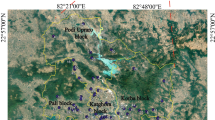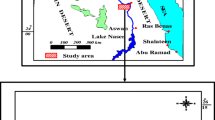Abstract
A steady state groundwater flow simulation model was developed using available well data and general hydrogeological and geological information, for the Afram Plains area, Ghana. The hydrochemistry of groundwater from wells in the area was then evaluated to determine its suitability for irrigation and domestic uses. The assessment of the irrigation quality of groundwater from this area was based on salinity (EC) and sodium adsorption ratios (SAR), residual sodium carbonate (RSC), and permeability indices (PI). The simulation model reveals that groundwater in the Afram Plains area generally flows from the midsections in the neighborhood of Tease and surrounding areas, where significant recharge takes place, to the outer regions and discharges into the Volta Lake in the southern and eastern sections of the area. Flow magnitude and piezometric maps suggest that there is probably of less potential for groundwater extraction for sustainable irrigation in the central regions of the area, when compared to the other discharge areas. This study reveals that more than 70% of the samples analyzed fall within the C2–S1 category, referring to the medium level salinity and low sodium. Medium salinity waters may be used for irrigation on coarse textured soils with good permeability. About 15% of the data fall within the C3–S2 category, referring to water of high salinity and medium sodicity. High salinity, medium sodicity irrigation water cannot be used on fine-grained soils where drainage is restricted. This is because restricted flow is likely to result in the accumulation of salts in the root zones of crops, leading to salinity and soil clogging crisis. About 3% falls within the C3–S3 (high salinity, high sodicity) category. This category requires special soil management including improved drainage, heavy leaching and the use of chemical amendments on the water. Only one point plots within the extreme salinity–sodicity range. Concentrations of fluoride, arsenic and other natural elements in the area generally fall well within the world health standards for domestic water.











Similar content being viewed by others
References
Acheampong SY (1996) Geochemical evolution of the shallow groundwater system in the southern Voltaian Sedimentary Basin of Ghana. PhD, University of Nevada, Reno, USA
Acheampong SY, Hess JW (1998) Hydrogeological and hydrochemical framework of the shallow groundwater system in the southern Voltaian Sedimentary Basin, Ghana. Hydrogeol J 6:527–537
African Development Fund (2006) Republic of Ghana: Afram Plains agricultural development project appraisal report
Don NC, Hang NTM, Araki H, Yamanishi H, Koga K (2006) Groundwater resources management under environmental constraints. Environ Geol 49:601–609
Doneen LD (1966) Water quality requirement for agriculture. In: Proceedings of the national symposium quality standards for natural waters. University of Michigan, Ann Report, pp 213–218
Ebraheem AM, Garamoon HK, Riad S, Wycisk P, Seif El Nasr AM (2003) Numerical modeling of groundwater resource management options in the East Oweinat area, SW Egypt. Environ Geol 44:433–447
Emch PG, Yeh W-G (1998) Management model for conjunctive use of coastal and surface water and groundwater. J Water Resour Plan Manag 124:129–139
Engel S, Iskandarani M, Useche MP (2003) Improved water supply in the Ghanaian Volta Basin: who uses it and who participates in community decision-making? In: The Annual Conference of International Association of Agricultural Economists (IAAE), Durban, South Africa
Environmental Modeling Research Laboratory (2004) Groundwater Modeling Software Version 5.0 Manual. Brigam Young University
Freeze RA Cherry JA (1979) Groundwater. Prentice Hall, New Jersey
GEF-NEP (2002) Volta River Basin preliminary transboundary diagnostic analysis. Final Report, Project Development Facility (PDF-B), Accra
Gill HE (1969) A groundwater Reconnaissance of the Republic of Ghana, with description of geohydrolic provinces. US Geological Survey Water Supply Paper, 1757-k
Junner NR, Hirst T (1946) The geology and hydrogeology of the Volta Basin. Gold Coast Geological Survey, Memoir 8
Junner NR, Service H (1936) Geological notes on Volta River District and Togoland under British mandate. Annual Report on the Geological Survey by the Director, 1935–1936
Kelly WP (1951) Alkali soils—their formation, properties and reclamation. Reinhold, New York
McDonald MG, Harbaugh AW (1988) A modular three-dimensional finite-difference groundwater flow model. Techniques of Water Resources Investigations, 06A1, USGS, 576p
Minor T, Russel C, Chesley M, Englin J, Sander P, Carter Knowles R, Acheampong SY, McKay A (1995) Application of geographic information systems technology to water well citing in Ghana, West Africa: feasibility study. Desert River Research Institute, Publication No. 44033, 168p
Schroeder HA, Tipton IH, Nason P (1972) Trace metals in man: strontium and barium. J Chronic Dis 25:491–517
Stockinger HE (1981) The metals. In: Clayton GD, Clayton FE (eds) Patty’s industrial hygiene and toxicology, 3rd edn, vol 2A. Wiley, New York, pp 1493–2060
Uddameri V, Kuchanur M (2007) Simulation-optimization approach to assess groundwater availability in Refugio County, TX. Environ Geol 51:921–929
USSL (1954) Diagnosis and improvement of saline and alkali soils. USDA Agr. Handbook No. 60, Washington D.C
WHO (1996) Guidelines for drinking-water quality, 2nd edn, vol 2. Health criteria and other supporting information, Geneva
WHO (2002) Fluorides. Environmental health criteria 227, Geneva
WHO (2004) Guidelines for drinking water quality. In: Recommendations, 3rd edn, vol 1. World Health Organization, Geneva
Wilcox IV (1955) Classification and use of irrigation water. US Department of Agriculture, Circ. 696. Washington DC
Yidana MS, Ophori D, Banoeng-Yakubo B (2007) Hydrogeological and hydrochemical characterization of the Voltaian Basin: the Afram Plains area, Ghana. Env Geol. doi:10.1007/s00254-007-07 10-1
Zhou X, Chen M, Liang C (2003) Optimal schemes of groundwater exploitation for prevention of seawater intrusion in the Leizhou Peninsula in Southern China. Environ Geol 43:978–985
Author information
Authors and Affiliations
Corresponding author
Rights and permissions
About this article
Cite this article
Yidana, S., Ophori, D. & Banoeng-Yakubo, B. Groundwater availability in the shallow aquifers of the southern voltaian system: a simulation and chemical analysis. Environ Geol 55, 1647–1657 (2008). https://doi.org/10.1007/s00254-007-1114-y
Received:
Accepted:
Published:
Issue Date:
DOI: https://doi.org/10.1007/s00254-007-1114-y




